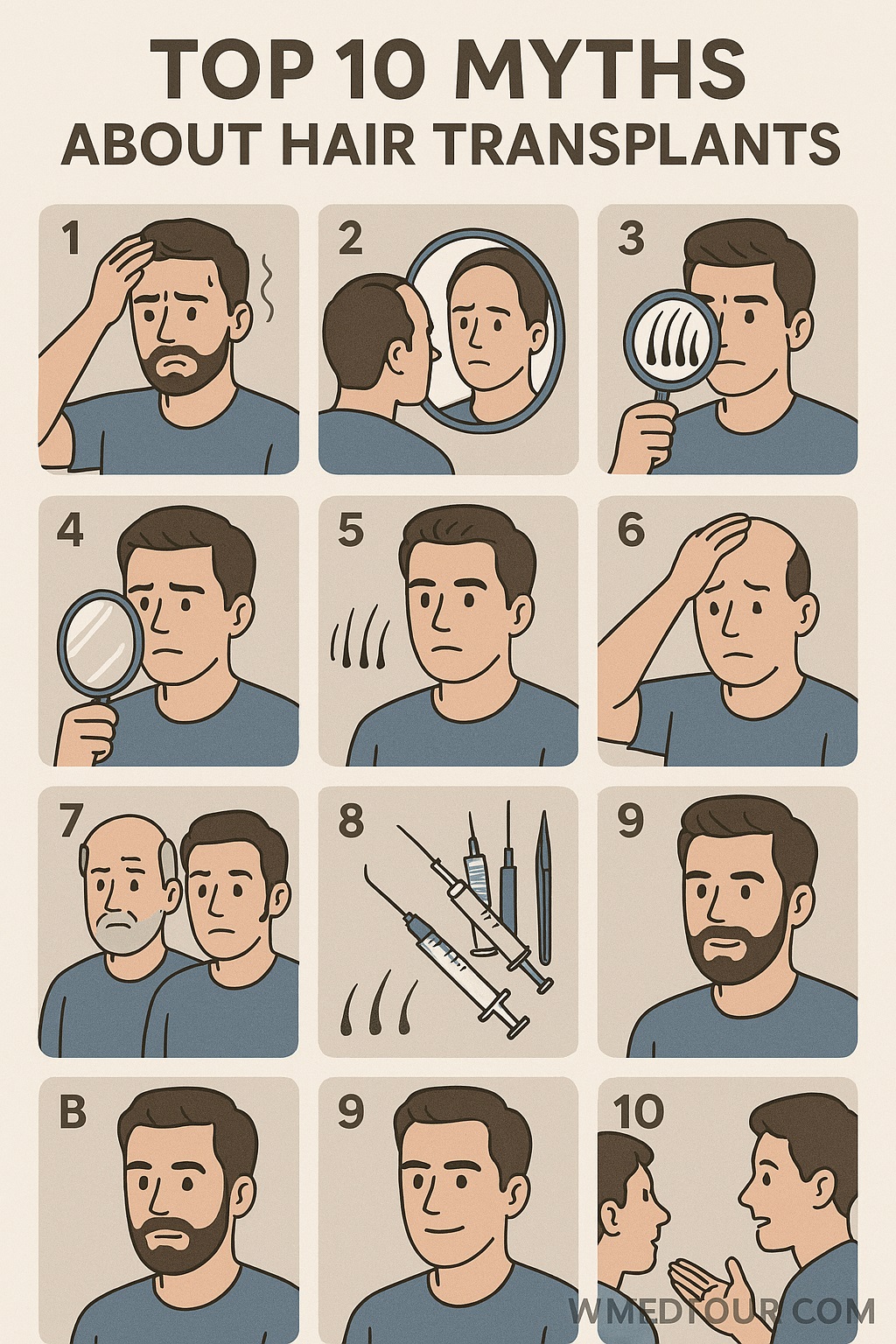Top 10 Hair Transplant Myths: Debunking the Facts and Fiction
Considering a hair transplant? You’ve likely heard a lot of information, and frankly, a lot of misinformation. The world of hair restoration is often clouded by myths and misconceptions that can prevent people from seeking a life-changing solution. From concerns about unnatural-looking results to fears of intense pain, these persistent myths can be daunting. But what’s the real story? At WMedtour, we believe in arming our patients with the truth. That’s why we’re here to set the record straight and debunk the top 10 hair transplant myths once and for all.
Hair loss can be a deeply personal and emotional journey. When you finally decide to explore a solution, it’s crucial to have accurate, reliable information. This guide will walk you through the most common falsehoods and replace them with factual insights, helping you feel confident and empowered as you take the next step. So, let’s separate fact from fiction and reveal the truth behind modern hair transplantation.
Myth #1: Hair Transplants Are Only for Men
This is one of the most widespread misconceptions. While male pattern baldness is a very common reason for a hair transplant, hair loss affects millions of women as well. Female hair loss can be caused by various factors, including genetics, hormonal changes, and certain medical conditions. In fact, many women are excellent candidates for hair restoration. Modern techniques like FUE and DHI are highly effective for women, providing natural-looking and long-lasting results. We’ve created a complete guide for women’s hair transplants to help you understand the process and your potential candidacy.
Myth #2: The Results Look Unnatural and Like a “Doll’s Head”
Remember those old hair plugs from the 1980s? The ones that looked like perfectly spaced tufts of hair? This myth stems directly from those outdated techniques. Thankfully, hair transplant surgery has evolved dramatically. Today’s surgeons use advanced methods like Follicular Unit Extraction (FUE) and Direct Hair Implantation (DHI) to transplant individual follicular units. These techniques allow for meticulous placement of grafts at natural angles and densities, blending seamlessly with your existing hair. The result is a hairline that is virtually undetectable and completely natural. The success of the outcome often depends on choosing a skilled and experienced surgeon. Learn how to choose the best surgeon for your procedure.
Myth #3: Hair Transplants Are Extremely Painful
The idea of a surgical procedure on your head sounds painful, but the reality is quite different. The entire procedure is performed under local anesthesia. This means you won’t feel any pain during the surgery itself, only a slight initial pinch from the anesthetic injection. Post-procedure discomfort is minimal and can be easily managed with over-the-counter pain medication. Most patients describe the recovery as being more uncomfortable than painful. For more details on what to expect, read our guide on pain during and after a hair transplant.
Myth #4: Hair Transplants Are Unaffordable for Most People
While the cost of a hair transplant can be a significant investment, it’s a long-term solution to a lifelong problem. When you consider the ongoing cost of temporary solutions like special shampoos, topical treatments, and wigs, a hair transplant often proves to be more cost-effective in the long run. Furthermore, the cost varies widely depending on the number of grafts needed and the location of the clinic. Many people find that seeking treatment abroad in countries with high-quality clinics and lower overhead, like Turkey, makes the procedure much more accessible. Get a detailed breakdown of hair transplant costs to help with your financial planning.
Myth #5: Transplanted Hair Will Fall Out Over Time
This is a common fear, but it’s fundamentally untrue. The hair follicles used in a hair transplant are typically taken from the “donor area,” usually the back and sides of the head. These follicles are genetically resistant to the effects of dihydrotestosterone (DHT), the hormone responsible for pattern baldness. Because these follicles retain their genetic programming, they will continue to grow healthily in their new location for a lifetime. While you will experience some shock loss in the initial weeks, this is temporary and part of the normal growth cycle. The transplanted hair will grow back and remain permanent.
Myth #6: You’ll Have a Huge Scar from the Surgery
This myth is a remnant of the older Follicular Unit Transplantation (FUT) method, which involved removing a strip of skin from the donor area, often leaving a linear scar. However, modern techniques like FUE and DHI are minimally invasive. With FUE, individual follicles are extracted, leaving behind tiny, pinprick-like scars that are virtually invisible, even with very short hair. DHI uses a specialized implanter pen for both extraction and implantation, resulting in even less trauma to the scalp and no visible scarring. The recovery process is quicker and more comfortable, as you can see in our guide to hair transplant recovery.
Myth #7: Hair Transplants Are Only for Young People
Age is just a number when it comes to hair transplants. While there is a best age for a hair transplant, it’s not a strict cutoff. The most important factor is the stability of your hair loss. If your hair loss has stabilized and you have a healthy donor area, you can be a good candidate for a hair transplant regardless of your age. We’ve seen successful procedures performed on people in their 20s and well into their 60s. Your suitability for a hair transplant is determined by a comprehensive consultation, not just your birth year. Our definitive checklist can help you determine your candidacy.
Myth #8: Hair Transplants Are Just a Cosmetic Fix
Categorizing hair transplants as “just cosmetic” dismisses their profound impact on a person’s mental and emotional well-being. Hair loss can lead to decreased self-esteem, anxiety, and depression. Restoring a full head of hair can be life-changing, boosting confidence and improving quality of life. For many, a hair transplant is an essential procedure that helps them feel like themselves again. It’s a journey of self-restoration, not just a superficial change. The emotional and psychological benefits are a huge part of the overall success rate of the procedure.
Myth #9: The Procedure Takes a Long Time to Recover From
In the past, hair transplant recovery could be lengthy. However, with the advent of advanced techniques, the recovery period is now relatively short. Most patients can return to work and light activities within a few days. The scalp will be red and slightly swollen, but these side effects typically subside within a week or two. Full recovery and the initial growth phase take a few months, but the immediate post-op period is surprisingly manageable. For a detailed timeline, check out our guide on what to expect during your recovery.
Myth #10: A Hair Transplant is a One-Time Fix for All Hair Loss
While a hair transplant provides a permanent solution for the transplanted hair, it does not stop future hair loss in the non-transplanted areas. Progressive hair loss is a natural process. To maintain a full head of hair, many patients opt for complementary treatments like PRP therapy or certain medications to strengthen their existing hair and prevent further thinning. It’s important to have a long-term plan with your doctor. This isn’t just about a single procedure; it’s about a lifelong approach to managing hair health.
Myth vs. Fact: A Quick Comparison
Let’s summarize the key points to help you visualize the truth about hair transplantation. This table breaks down the most common myths and the corresponding facts.
| Myth | Fact |
|---|---|
| Only men can get hair transplants. | Women are also great candidates and the procedure is highly effective for them. |
| The results look unnatural. | Modern techniques like FUE and DHI provide natural, undetectable results. |
| The procedure is extremely painful. | It’s performed under local anesthesia with minimal discomfort. |
| Hair transplants are unaffordable. | They are a long-term, cost-effective solution, especially when considering medical tourism. |
| Transplanted hair will fall out. | Transplanted hair is permanent and will not fall out. |
| You will have a huge scar. | FUE and DHI leave minimal to no visible scarring. |
| Hair transplants are only for young people. | Candidacy is based on the stability of hair loss, not age. |
| It’s just a cosmetic procedure. | It has a significant positive impact on mental health and self-esteem. |
| Recovery takes a long time. | Recovery is relatively quick, with most patients returning to normal activities within a few days. |
| It’s a one-time fix for all hair loss. | While transplanted hair is permanent, a long-term plan is needed to manage future hair loss. |
Beyond the Myths: The Journey to Hair Restoration
Now that you have the facts, you can make a more informed decision about your hair restoration journey. Choosing to undergo a hair transplant is a significant step, and it’s essential to partner with a clinic that prioritizes transparency, expertise, and patient care. At WMedtour, we specialize in providing high-quality, affordable hair transplants in Turkey, utilizing the most advanced methods available.
The WMedtour Difference: Why Trust Us with Your Hair
We understand that navigating the world of medical tourism can feel overwhelming. Our mission is to make the process as seamless and stress-free as possible. We offer all-inclusive packages that cover your treatment, accommodation, and transfers, so you can focus on your recovery and enjoy a comfortable experience. Our network of surgeons and clinics are world-class, with a proven track record of successful outcomes. Whether you’re considering the number of grafts you need and the type of hair loss you have, we are here to guide you every step of the way.
Don’t let misinformation hold you back from regaining your confidence. Explore the possibilities with WMedtour today. We are committed to helping you achieve a natural, permanent, and life-changing result. For more information, please feel free to contact us and schedule a free consultation.
Frequently Asked Questions About Hair Transplants
We’ve answered some of the most common questions to provide you with additional clarity and peace of mind. For an even more comprehensive list, check out our full Hair Transplant FAQ page.




